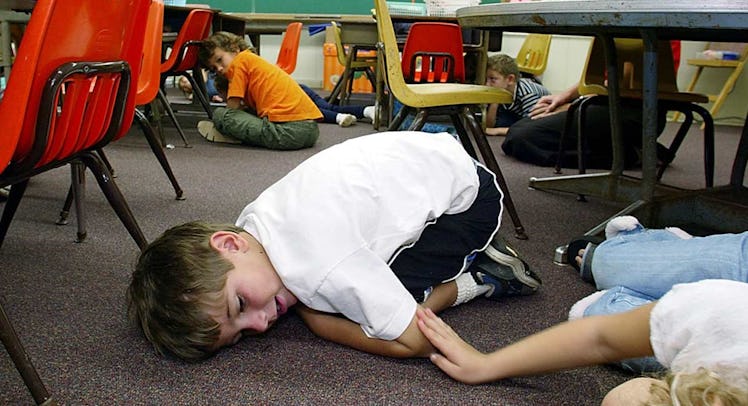Can ALICE Training Protect Grade School Kids From School Shooters?
ALICE, a program that has trained over 1 million people in the United States on what to do in the event of an active school shooter, has significant praise. It also has significant criticism.

There’s no reason to believe that school shootings will stop. Despite the efforts of activists and educators, the next Sandy Hook or Stoneman Douglas still feels — thanks to the ubiquity of firearms and the poverty of resources for kids with serious emotional issues — inevitable. It’s no wonder that shooting preparedness is a growing industry or that parents and teachers and superintendents go looking for defensive solutions to active shooters, many of which seem like PG-rated security theater. To look closely at ALICE training, the most popular training program, is to see well-intentioned people doing their best, but also to confront the truth that there is, very literally speaking, nowhere to hide.
ALICE stands for Alert, Lockdown, Inform, Counter, and Evacuate. The ALICE Training Institute, a for-profit business that sells engagements to school systems, claims that their program is superior to competitors because it twists the traditional “lockdown only” training programs in order to focus on active shooter situations. When officials are training kids, they use workbooks, reading books, and class discussions as well as short drills to teach kids how to use each one of those methods. On their website, ALICE notes that the full training could take years just using the instructor-model (ALICE training instructors coming onto campuses) or a blended model of online classes and instructor training, which could take weeks. Kids don’t get that kind of time. Classes tend to be quick. That’s part of the appeal of these to colleges, businesses, governments, and houses of worship. All in, over 1 million people have been trained in the ALICE training method.
But there might be more than meets the eye to training programs like ALICE. Kenneth Trump, (no relation) president of the National School Safety and Security Services, is an outspoken critic of the program. Specifically, he takes issue with ALICE training that pushes the idea that children can and should attack shooters or impede them by throwing books and pencils and making loud noises. The idea is that panicked murderers are easily put off by resistance, but the reality is that empowering kids to fight back is a way to avoid acknowledging how that fight will likely end.
“While ALICE advocates may be well-intentioned,” Trump says, “the trainers and people pushing the program often come largely from outside of K-12 school settings and fail to factor in age and developmental issues, special needs children, autistic, emotional and behavioral disorders, physically challenged, and other unique considerations of school and child-centered settings.”
The ALICE training program was not developed by and is not overseen by school professionals, who are more aware of children’s abilities, but teaching professionals still have a very strong role in the way the program is taught at their schools. They participate in the training and elect to become trained in the ALICE method. Kids, for their part, are given half-day workshops. Representatives of the ALICE Training Institute couldn’t be reached for comments on the specifics agendas of their programs.
“Teaching kids in a one-shot assembly to swarm an armed gunman who could be strapped with explosives is irresponsible,” says Trump, adding that police officers spend decades being trained and retrained for this sort of work.
Because it’s hard to pin down how consistent ALICE training is and because Trump’s critique of the program tends toward the tactical, his objection seems to be largely about the idea of efficacy. Is it possible that ALICE works? There is ultimately only one way to find out and, fortunately, no shooter has attacked an ALICE-trained school to date. That said, in the event of that tragedy, it will remain hard to assess the efficacy of the program. Will fewer children be killed because of ALICE? It will be impossible to say. There is no control group. The variables stack up quickly. And kids can always be accused of not doing it right. After all, they’ve received very little training (some states are now mandating school shooting training, but a significant amount of time is not being devoted to it).
This is why Trump believes that regular lockdown and evacuation drills and detailed plans that are acted upon on a daily basis (and common sense values like not letting strangers onto school property) are the only way to really protect children from danger. He also believes in school security despite the fact that there was an armed police officer at Columbine High School and a significant body of research shows that having police in schools makes children feel less safe, not more.
There are problems with ALICE. It offers flexibility, cheapness, and ease, which are not things that should be considered in the context of mass murder. But there are also good things about ALICE, including the fact that it just might help. But is that enough?The debate over ALICE and over school shooting preparedness is, on one level, a fight over the future of a growing industry, and, on another level, a contentious form of unanimity: The people arguing all believe that more schoolchildren will be killed. They all believe that not enough is being done. They all believe that mentally ill people will get their hands on guns and turn those guns on those incapable of protecting themselves. They can debate defense as much as they want, but they agree on the big idea. Unfortunately, they are right.
This article was originally published on